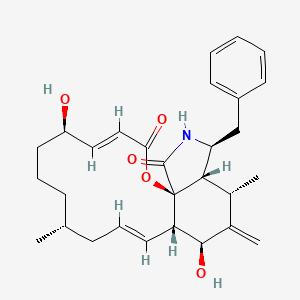| MeSH term | MeSH ID | Detail |
|---|---|---|
| Hemolysis | D006461 | 131 associated lipids |
| Tuberculosis | D014376 | 20 associated lipids |
| Uremia | D014511 | 33 associated lipids |
| Diabetes Mellitus | D003920 | 90 associated lipids |
| Adenocarcinoma | D000230 | 166 associated lipids |
| Dermatitis, Contact | D003877 | 59 associated lipids |
| Lupus Erythematosus, Systemic | D008180 | 43 associated lipids |
| Lung Neoplasms | D008175 | 171 associated lipids |
| Wounds and Injuries | D014947 | 20 associated lipids |
| Adenoma, Islet Cell | D007516 | 7 associated lipids |
CYTOCHALASIN B
CYTOCHALASIN B is a lipid of Polyketides (PK) class. Cytochalasin b is associated with abnormalities such as Renal tubular disorder and Chagas Disease. The involved functions are known as Membrane Protein Traffic, inhibitors, Metabolic Inhibition, Biochemical Pathway and Increased Sensitivy. Cytochalasin b often locates in Cytoplasmic matrix, Plasma membrane, Microtubules, Extracellular and Protoplasm. The associated genes with CYTOCHALASIN B are SLC2A2 gene, PFDN5 gene, SLC2A1 gene, OMG gene and SPEN gene. The related lipids are Steroids, Lipopolysaccharides and Liposomes. The related experimental models are Xenograft Model.
Cross Reference
Introduction
To understand associated biological information of CYTOCHALASIN B, we collected biological information of abnormalities, associated pathways, cellular/molecular locations, biological functions, related genes/proteins, lipids and common seen animal/experimental models with organized paragraphs from literatures.
What diseases are associated with CYTOCHALASIN B?
CYTOCHALASIN B is suspected in Renal tubular disorder, Chagas Disease and other diseases in descending order of the highest number of associated sentences.
Related references are mostly published in these journals:
| Disease | Cross reference | Weighted score | Related literature |
|---|
Possible diseases from mapped MeSH terms on references
We collected disease MeSH terms mapped to the references associated with CYTOCHALASIN B
PubChem Associated disorders and diseases
What pathways are associated with CYTOCHALASIN B
There are no associated biomedical information in the current reference collection.
PubChem Biomolecular Interactions and Pathways
Link to PubChem Biomolecular Interactions and PathwaysWhat cellular locations are associated with CYTOCHALASIN B?
Visualization in cellular structure
Associated locations are in red color. Not associated locations are in black.
Related references are published most in these journals:
| Location | Cross reference | Weighted score | Related literatures |
|---|
What functions are associated with CYTOCHALASIN B?
Related references are published most in these journals:
| Function | Cross reference | Weighted score | Related literatures |
|---|
What lipids are associated with CYTOCHALASIN B?
Related references are published most in these journals:
| Lipid concept | Cross reference | Weighted score | Related literatures |
|---|
What genes are associated with CYTOCHALASIN B?
Related references are published most in these journals:
- Am. J. Physiol., Cell Physiol. (2)
- Am. J. Physiol. Renal Physiol. (1)
- Biochim. Biophys. Acta (1)
- Others (8)
| Gene | Cross reference | Weighted score | Related literatures |
|---|
What common seen animal models are associated with CYTOCHALASIN B?
Xenograft Model
Xenograft Model are used in the study 'Endofacial competitive inhibition of the glucose transporter 1 activity by gossypol.' (Pérez A et al., 2009).
Related references are published most in these journals:
| Model | Cross reference | Weighted score | Related literatures |
|---|
NCBI Entrez Crosslinks
All references with CYTOCHALASIN B
Download all related citations| Authors | Title | Published | Journal | PubMed Link |
|---|---|---|---|---|
| Mueckler M and Makepeace C | Ligand-induced movements of inner transmembrane helices of Glut1 revealed by chemical cross-linking of di-cysteine mutants. | 2012 | PLoS ONE | pmid:22363641 |
| Terashita Y et al. | Latrunculin A can improve the birth rate of cloned mice and simplify the nuclear transfer protocol by gently inhibiting actin polymerization. | 2012 | Biol. Reprod. | pmid:22492972 |
| Ojeda P et al. | Noncompetitive blocking of human GLUT1 hexose transporter by methylxanthines reveals an exofacial regulatory binding site. | 2012 | Am. J. Physiol., Cell Physiol. | pmid:22673619 |
| Bentley PA et al. | Characterization of bovine glucose transporter 1 kinetics and substrate specificities in Xenopus oocytes. | 2012 | J. Dairy Sci. | pmid:22365203 |
| Mace OJ et al. | The regulation of K- and L-cell activity by GLUT2 and the calcium-sensing receptor CasR in rat small intestine. | 2012 | J. Physiol. (Lond.) | pmid:22495587 |
| Chan HH et al. | Bioactive constituents from the roots of Panax japonicus var. major and development of a LC-MS/MS method for distinguishing between natural and artifactual compounds. | 2011 | J. Nat. Prod. | pmid:21417387 |
| Robichaud T et al. | Determinants of ligand binding affinity and cooperativity at the GLUT1 endofacial site. | 2011 | Biochemistry | pmid:21384913 |
| SerebrianyÄ AM et al. | [Distribution of individuals by spontaneous frequencies of lymphocytes with micronuclei. Particularity and consequences]. | 2011 | Tsitologiia | pmid:21473112 |
| Sun SC et al. | Arp2/3 complex regulates asymmetric division and cytokinesis in mouse oocytes. | 2011 | PLoS ONE | pmid:21494665 |
| Porter-Turner MM et al. | Relationship between erythrocyte GLUT1 function and membrane glycation in type 2 diabetes. | 2011 | Br. J. Biomed. Sci. | pmid:22263435 |
